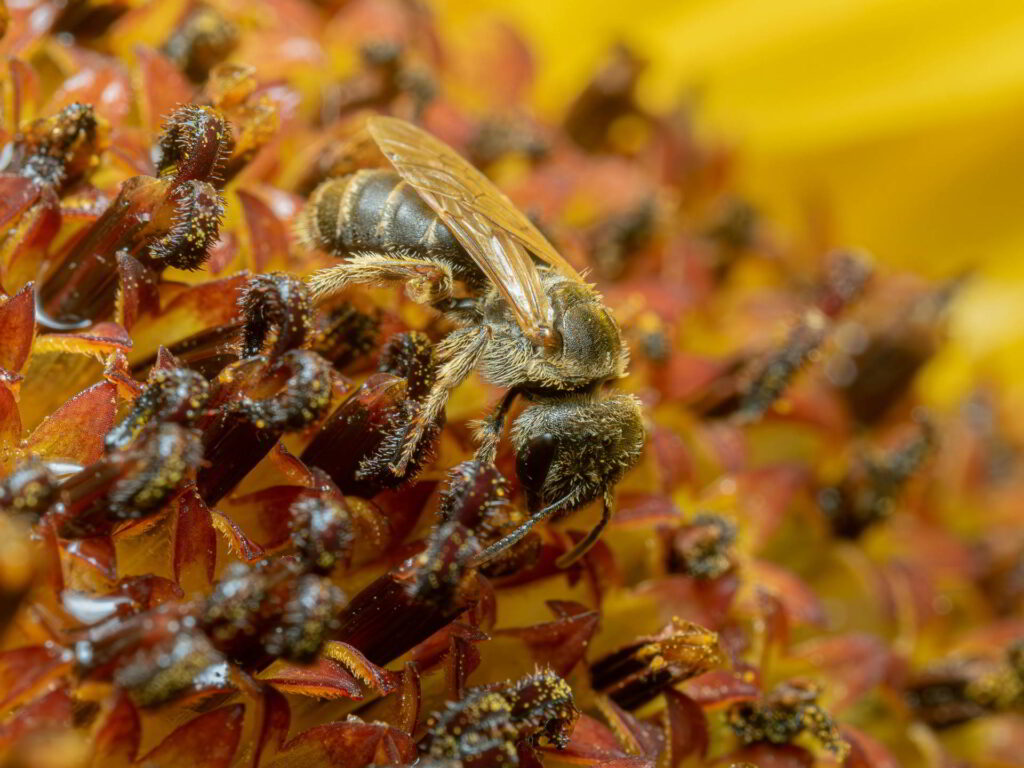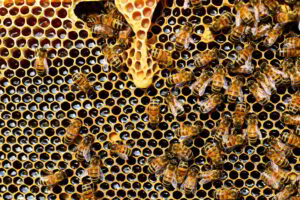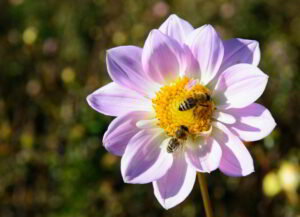Understanding Bee Colony Dynamics
Spring’s almost here, and it’s time for beekeepers to crack open the books on bee colony behaviors. This know-how’s a game-changer for anyone trying to ace spring beekeeping management.
Swarming Tendencies
Swarming usually pops up in late spring — it’s nature’s way of calling for a hive road trip. The bees are pumped up from having all that nectar and pollen. Things get crowded at home when the bee babies, or brood, start growing like weeds and everyone’s buzzing with excitement. If you wanna keep from losing bees to swarming, keep a close watch on what’s happening in the hive.
Swarming Factors:
- Too many bees, not enough room
- Nowhere for the new eggs and larvae to hang out
- Crummy air flow
You gotta peek into those hives often and give them extra space if needed. We spill the beans on this in our spring beekeeping checklist.
Queen Rearing
Spring’s when beekeepers get busy-building their hive empires. Some grab a package of worker bees with a queen, while others snatch up nucleus colonies (nucs). Nucs are like bee starter packs with frames loaded with honey, brood, pollen, and a queen bee running the show. Breeding a strong queen is like adding NOS to your bee colony’s engine.
Queen Rearing Options:
- Package Bees: Comes with a couple of pounds of buzzing workers and their queen.
- Nucleus Colonies: This setup often includes a handful of comb frames stocked with brood, honey, and a mated queen.
Buzz over to our spring beekeeping techniques for some savvy on queen rearing.
Hive Overcrowding
When spring rolls around, the honeybee queen’s laying spree kicks off, filling the hive to the brim as the days get longer and warmer. Early blooming flowers sweeten the deal, and the hive starts bursting at the seams (Penn State Extension).
Overcrowding Indicators:
- Honey storage’s exploding
- The brood’s packed in tight
- Seemed like the party’s moved outside the hive with bees hanging out
Tackle this by giving them room to breathe — either toss in more supers or do the splits. Our spring beekeeping tips have your back.
Getting a handle on these buzzing details means smoother spring beekeeping practices, keeping swarms in check, and cranking up those honey-filled returns.
Initiating Brood Rearing in Spring
Spring’s here! Bees kick it up a notch, getting all busy for the coming blooms. Wrangling those buzzing workers just right is key for a winning season.
Resuming Egg-Laying
As winter sneaks out and spring steps in, queen bees start popping eggs like popcorn at a movie. This go-time hinges on longer daylight, warmer vibes, and flowers daring to show their faces first (Penn State Extension).
| Month | Queen Activity | Worker Activity |
|---|---|---|
| January | A bit of egg action | Keeping the crib snug |
| March | Spreading drone egg rumors | Hunting for that golden pollen (Keeping Backyard Bees) |
| June | Egg frenzy | Foraging and tidying up the hive |
Factors Influencing Brood Rearing
What gets the hive groove going, you ask? Check out these buzzworthy factors:
- Temperature: Those crazy cold-to-warm swings in late winter and spring play with hive vibes. You gotta pick your moments when adding new stuff.
- Seasonal Patterns: Brood timing dances to the seasons, with barely any new workers showing up in January. But, as soon as pollen parties hit, brood cells peak at like 40,000.
| Factor | Impact on Brood Rearing |
|---|---|
| Temperature | Funky swings can hold up the hive rave |
| Day Length | More sun pushes queens to lay more eggs |
| Food Availability | Early pollen is the bees’ pre-workout shake |
Prepping the hive for spring means getting these factors in line. Need more tips? Peek at our spring beekeeping checklist and spring beekeeping tips.
To wrap it up, handling brood rearing just right is a biggie as bees shake off that winter chill for spring shenanigans. Nail those vital parts, and your bees will live the high life all season long. Want even more tricks? Check out our spring beekeeping practices and spring beekeeping techniques.
Spring Diseases and Management
Common Brood Diseases
Spring hits, and honey bee homes face a battleground of brood diseases. Knowing the enemy is half the battle. Time for some bee war tactics from the spring beekeeping playbook.
- Chalkbrood: This nasty fungus makes bee babies look like tiny chalk statues. Usually pops up when things get soggy and cold, or when the bees are stressed out.
- Sacbrood: Virus alert. Picture larvae turned into lil’ sacs, not moving much. Typically shows up when the colony’s not feeling its best or when the weather’s meh.
- European Foulbrood: A tough bacteria that takes down baby bees before they even get capped, leaving behind a gory mess. Watch for it when your bees are stressed and hungry or stuck with lousy weather.
Beekeepers, it’s game time. Keep your bee crew healthy with plenty of flowers and some extra snacks on the side. Check out Penn State Extension for more bee health hacks.
Supplemental Feeding for Diseases
Bee munchies—essential when Mother Nature decides to play hard to get with her nectar goodies.
| Type of Feed | Benefits | Usage |
|---|---|---|
| Sugar Syrup | Quick energy boost | Perfect at the start of spring when flowers hit snooze (Beekeeping For Newbies) |
| Pollen Substitutes | Protein punch | Vital when flowers share the pollen wealth sparingly or for raising new bee generations |
| Medicinal Syrup | Health kick in a bottle | Handy for fighting off pesky bugs like Nosema and Foulbrood |
Heads Up:
- Keep an eye on the queen—she’s the star player. If she’s slacking, the hive will show it. Check for a healthy spread of eggs, larvae, and capped brood to keep those honey stores up.
- March brings hive hustle—bees start stretching their wings and collecting goodies for the future (Keeping Backyard Bees).
Rocking solid disease management and giving your bees a nutritional leg up create a strong start to spring beekeeping that keeps the colony buzzing. Need more bee brilliance? Peek at our spring beekeeping checklist and grab some tips.
Establishing New Colonies in Spring
Purchasing Packages
One way to kick off new colonies in spring is by snagging some bee packages. You’re looking at about 10,000 buzzing worker bees and a queen in each. It’s a speedy way for beekeepers to jump on the nectar boom in May and June (Penn State Extension).
Why It’s Great:
- Less likely to catch bee bugs or nasty parasites.
- Easy to find and get hold of.
- Simple to move and deal with.
| Package Size | Number of Bees | Included Queen |
|---|---|---|
| Standard | ~10,000 | 1 queen |
| Large | ~12,000 | 1 queen |
| Small | ~8,000 | 1 queen |
Heads Up:
- Queens might not be top-notch due to bulk making.
- Need to keep an extra eye on them at the start (spring beekeeping checklist).
Looking after your new bee package right is key. This means feeding them syrup and checking they settle in well into their new digs. For more friendly advice, swing by our spring beekeeping tips.
Utilizing Nucleus Colonies
Another way to kick off your bee crew is by using nucleus colonies, or “nucs” for short. These come with frames chock-full of comb with bees, brood, pollen, honey, and yep, a queen (Penn State Extension).
Perks:
- Already got some babies and food ready.
- Nucs hit the ground running ’cause they’ve got a queen who’s all systems go.
- Tough cookies when it comes to early problems and stress.
| Nucleotide Colony Size | Frames | Included Queen |
|---|---|---|
| Standard | 5 | 1 queen |
| Extended | 10 | 1 queen |
Be Careful:
- Might need a bit more dough upfront than packages.
- Can come with local cooties unless you’re shopping smart.
Make sure you’re getting your bees from the best to sidestep diseases or itchy nasties. For the full scoop on nuc setup, have a look at our spring beekeeping practices.
Setting up new bee colonies in spring is a must for spring beekeeping management. Whether you’re going for packages or nucs, both have their perks to ready your hives for springtime buzzing. Happy beekeeping!
Managing Swarming Behavior
Monitoring Swarming
When the bees get their spring fever, you know swarming season has arrived. Bees swarm when food’s plenty, like when flowers are showing off. This is the part where swarming becomes their thing, courtesy of Mother Nature. Keeping your eyes peeled through regular hive checks will save you a buzzing headache.
Signs the Bees Might Be Planning a Getaway:
- Queen cells perking up.
- The hive’s feeling like rush hour.
- The queen has put her egg-laying duties on a diet.
- Drones seem to be throwing a party.
Peering into your hive often keeps you in the know and helps nip swarming in the bud. Here’s how you can outsmart this natural tendency:
- Add More Brood Frames: Reduces the bee-traffic jam inside.
- Provide Honey Supers: They give bees room for their sweet stash, cutting down on crowding.
- Split the Hive: By setting up an offshoot of the main hive, you keep the swarming urge at bay.
Artificially Rearing Queens
When bees’ baby fever hits in late spring, it’s a prime moment for beekeepers to step up their game and have a say in how their hive runs the show (Penn State Extension). By getting hands-on with queen rearing, you give genetic traits a makeover and fine-tune the hive’s productivity.
How to Rear Queens Like a Boss:
- Grafting Larvae: Sneak young larvae into those queen cups.
- Prepping Nucs: Make sure these mini hives have all they need—comb, brood, honey, and pollen.
- Plop in the Queen Cells: Set the queen cells snug into the ready-to-go nucs.
By taking charge of queen rearing, you not only keep that swarming itch under control but boost your hive’s overall vibe. To dig into setting up new colonies and killer spring beekeeping practices, hop over to our deep-dive guide.
Swarming Management Techniques
| Technique | What You Do | Why It’s Awesome |
|---|---|---|
| Adding Brood Frames | Create more room for brood | Cuts down on hive traffic, curbs swarming urges |
| Providing Honey Supers | More honey storage | Eases crowding, gives bees elbow room |
| Splitting Hive | Start a bee family spin-off | Drops population pressure, postpones swarming |
| Artificially Rearing Queens | In-house queen production | Guarantees top-notch queens, controls genetics |
Poking around the hive and having a trick-or-two ready keeps your bee squad from wanting to bolt. For more spring beekeeping advice and sneaky ways to stay ahead, check out our well-stocked resources.
Challenges and Solutions in Spring Beekeeping
Springtime brings a mixed bag for beekeepers as they prep their hives for action. Let’s check out some focus areas that’ll help make your spring beekeeping rock.
Colony Loss Rates
Losing bee colonies during winter is a bummer beekeepers dread. The numbers say it all: Winter 2020-2021 saw a whopping 32.2% of managed colonies in the U.S. vanish into thin air. Backyard keepers had it rougher than folks running sideline or big-time operations. This data screams for slicker ways to keep our bee buddies thriving through the icy months.
| Beekeepers | Colony Loss Rate (%) |
|---|---|
| Backyard Beekeepers | Ouch—needs exact numbers |
| Sideliners | Better off—exact numbers needed |
| Commercial Beekeepers | Same as above, need figures! |
What’s the game plan? Stick to those spring beekeeping practices and keep an eye on those hives all winter long.
Examination of Dead-Out Hives
Enticing, right? Checking out dead hives in spring ain’t glamorous, but it spills the tea on what went wrong. Spotting troublemakers like varroa mites or small hive beetles gives you a leg-up (Beekeeping For Newbies). Peek inside and learn what might help you dodge a repeat disaster.
Keep your eyes peeled for:
- Unwanted guests (varroa mites, small hive beetles, wax moths)
- Starving bees (check food supplies)
- Insidious illnesses (brood diseases, nosema)
Want the foolproof approach? Peek at the spring beekeeping checklist.
Queen Health Assessment
Don’t go cheap with your queen—her health is everything in spring! As she ages, her ability to get things buzzing declines. Rummage through the hive for eggs and larvae to ensure the colony’s on track to grow and make that honey money (Beekeeping For Newbies).
Things to check:
- Eggs, larvae, and more eggs
- How she’s laying (steady and solid as a rock)
- Any signs of a granny queen in there
Keeping your queen in tip-top shape means a mighty fine colony. Need more tips? Skim through our piece on spring beekeeping techniques.




